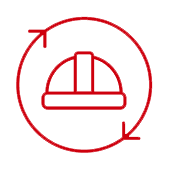Why use a demolition hammer for tunnel excavation
Versatility, flexibility and adaptability to the worksite conditions make demolition hammers the ideal choice for tunnel excavation
Using a demolition hammer for tunnel excavation is a choice based on very specific reasons. Natural tunnels are among the most complex constructions due to both logistical complications associated with excavation, consolidation and earth removal works, and due to the risk posed by so-called “geological uncertainty”. The choices made in the design phase based on the information provided by geognostics are not always in line with the real conditions found on site, having sometimes serious consequences on the progress of works, especially the efficacy and productivity of the pre-selected excavation and consolidation systems. While full-face mechanised excavation technologies (TBM – Tunnel Boring Machine) are particularly well known and widely used today thanks to their rapid execution, it is also true that this technology, on more than one occasion, has created enormous problems for the contractor and client in cases where the geomechanical conditions of the rock mass end up being different to the real ones, causing delays, huge economic losses and even dangerous situations for those working on site. Using a demolition hammer for tunnel excavation, on the other hand, allows fast and economical adaptation to the changing characteristics of the rock mass.
How a demolition hammer works
A demolition hammer is a machine designed to transform the energy of a pressurised fluid into mechanical energy in order to break a certain material. The impact between the striking hammer and the tool transforms the kinetic energy of the moving mass into impact energy, which, through the tool itself, is transferred to the material to be demolished.
Hydraulic hammers operate mainly in two different ways:
- Demolition by penetration
This consists of crushing rocky materials by combining stress waves and the wedge effect generated by the specially shaped tool. In this type of demolition, the sharpness and shape of the tool are key to achieving good hammer productivity.
- Demolition by impact
This technique is characterised by the fracturing of the material with stress waves alone, using flat tools. Typical applications include the demolition of large blocks and boulders.
The choice of tool is key to achieving maximum productivity from the hydraulic demolition hammer.
Drawing on our extensive experience in heavy-duty tunnel demolition, Indeco has developed a range of tools designed to deliver optimal performance in all conditions.
A formula for defining the tunnel excavation tool
Choosing the right technique for a natural tunnel excavation can be a complex decision-making process involving numerous factors that do not fall under a simple cost-benefit analysis. The decision naturally depends on geological considerations (RMR, RQD, GSI, etc.), but also the difficulties involved in the actual excavation process (excavation cycle – earth removal – consolidation). This decision also calls for logistical and economic evaluations concerning the number of employees, machines and equipment required, accessibility to the worksite, environmental restrictions, etc. When performing the initial general analysis of which excavation technique to use, Indeco proposes a “criteria matrix” in FocusOn, which takes into account the various factors affecting the choice of excavation machinery.
The excavation systems examined and compared include:
- Excavation using hydraulic demolition hammers
- Excavation with TBM (Tunnel Boring Machine)
- Excavation using explosives
Problems with TBM
Despite being considered the most efficient excavation technique in use today, TBM offers little flexibility and its use is not always advisable in the following scenarios:
- When there isn’t enough information regarding the homogeneity of the rock mass along the route
- In the event of high-level fracturing or particularly critical hydrogeological conditions
- In natural tunnels less than two kilometres long (the costs are too high)
- When the route involves particularly tight curves
- When a polycentric cross-section is required (instead of a perfect circle)
- When the logistical conditions make assembly/disassembly difficult
Problems with using explosives
A traditional excavation technique, blasting provides interesting yields provided the rock mass is compact enough to ensure an effective outcome. In cases where the rock mass presents limited hardness and especially fracturing, the explosive fails to guarantee satisfactory yields.
In these instances, hammers and explosives can be used as complementary techniques and therefore alternated in the event of clusters with varying conditions ranging from strong compactness and hardness to greater fracturing and lower hardness.
The benefit of a demolition hammer for tunnel excavation
Opting for a demolition hammer as an excavation technique is undoubtedly the best solution in tunnels characterised by geomechanical profiles and dimensions making it difficult or uneconomical to use other techniques such as full-face boring (TBM) or blasting. This is why hammers are being increasingly used throughout Italy, one of the countries boasting the highest number of natural galleries in the world, in a territory characterised by rock masses where excavation and consolidation are notoriously difficult.






